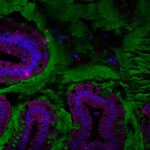Lien vers Pubmed [PMID] – 26512715
Lien DOI – 10.1097/MIB.0000000000000609
Inflamm Bowel Dis 2016 Jan; 22(1): 68-81
Adherent-invasive Escherichia coli (AIEC) associated with Crohn’s disease target M cells lining Peyer’s patches (PPs) through the expression of long polar fimbriae (LPF) and survive macrophage killing. Invasion of PPs constitutes a way to colonize the mucosa for bacteria able to escape or resist killing of underlying immune cells. We aimed to identify new virulence factors involved in PPs colonization by AIEC.The presence of gipA (Growth in PPs) gene was determined by polymerase chain reaction. In vivo experiments were performed using CEABAC10 transgenic mice. Intramacrophagic behavior of AIEC was assessed in murine bone marrow-derived macrophages and human monocyte-derived macrophages. Cytokines production was quantified by ELISA.A higher prevalence of gipA-positive E. coli was observed in patients with Crohn’s disease (27.3%) compared with controls (17.2%). Unlike non-AIEC strains, all gipA-positive AIEC strains also harbored lpfA. GipA deletion impaired AIEC translocation across M cells and their replication inside macrophages. GipA expression was induced by gastrointestinal (bile salts) and phagolysosomal (reactive oxygen species and acid pH) conditions. GipA deletion decreased lpfA mRNA level in AIEC bacteria. Survival of AIEC-ΔgipA bacteria was reduced in medium containing H2O2 or acidic pH. GipA deletion impaired AIEC colonization of PPs and dissemination to mesenteric lymph nodes in mice.GipA is required for optimal colonization of mouse PPs and survival within macrophages by AIEC, suggesting that this factor plays a role in AIEC promotion of Crohn’s disease. Detection of gipA and lpfA could be a predictor for the presence of AIEC.


